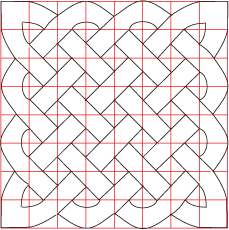Or search by topic
Number and algebra
Geometry and measure
Probability and statistics
Working mathematically
Advanced mathematics
For younger learners
Drawing Celtic Knots



- Problem
- Getting Started
- Student Solutions
- Teachers' Resources
Why do this problem?
The complexity in the seemingly simple patterns of Celtic knots have always fascinated people. This problem provides an accessible introduction to creating such patterns, with the chance to investigate some of the maths that arises along the way.
It could provide an excellent opportunity for forging cross-curricular links with Art and Design departments.
Possible approach
Learners could initially be shown images of Celtic knots to capture their interest. Then they could watch the videos to see two different ways of creating a basic knot.
Once they are ready to create their own knots, you may find it useful to print off some of these grids for learners to draw onto (Word, pdf).
Alternatively, it is fairly simple for learners to create their own grids by drawing faint diagonal lines on squared or square dotty paper. The straight lines needed to create the knots all go through the midpoints of the sides of the squares:

Once learners have got the hang of creating Celtic knots, encourage them to think of mathematical questions to ask - there are some suggestions in the problem. By getting everyone in the class to draw different knots, data can quickly be gathered and analysed. If learners have created their own grids, they may find that knots cannot be drawn on some grids - this is another line of enquiry that
can be explored.
Key questions
For rectangular knots, can you explain how the knot size determines the number of ribbons?
Is it possible to draw a rectangular Celtic knot without rotational symmetry?
Can you explain how the knot size determines the number of overlaps?
Possible extension
Introduce learners to more complicated Celtic knots - circular knots, knots with holes in, letters drawn as knots...
Possible support
Starting on smaller grids and encouraging learners to shade in where the ribbons will go can help. Suggest they use soft pencil, and be prepared to do lots of rubbing out!
Related Collections
You may also like
More on Mazes
There is a long tradition of creating mazes throughout history and across the world. This article gives details of mazes you can visit and those that you can tackle on paper.
Mathematical Patchwork
Jenny Murray describes the mathematical processes behind making patchwork in this article for students.
Turning the Place Over
As part of Liverpool08 European Capital of Culture there were a huge number of events and displays. One of the art installations was called "Turning the Place Over". Can you find our how it works?

